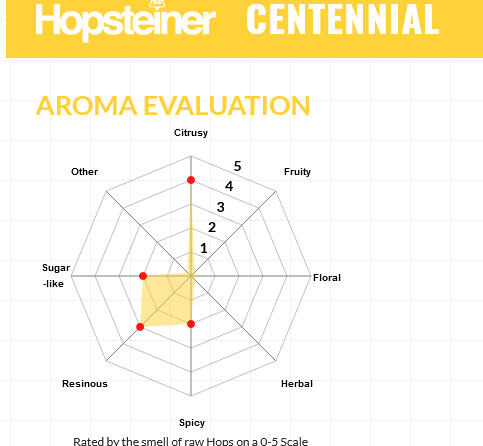This week I take a close look at hop sensory data which these days is often published on a “spider chart” by the major hop suppliers. Armed with this knowledge you can do a better job selecting hops for your beer.
Hop Sensory Data

Some time ago, I published an article on how hop sensory analysis is done and how you can easily do it at home or with a small group of people. I do recommend reading this article as it not only covers how you can analyze the hops you have on hand but also how to use this as a quick check of the freshness of your hops before brewing.
Fortunately most of the major hop producers now publish hop sensory data for each of their major varieties, often in the form of a spider chart like the one shown to the right from Hopsteiner describing the major aroma/flavors. This data is typically generated by a judging panel doing a dry rub of the fresh hops.
While there is some variation in the number of sensory aroma/flavors listed, most producers use at least six and sometimes as many as 12 axis on their charts. Here are the major aromas as well as the oils associated with them:
- Floral: A variety of flowery aromas including things like rose, lavender, lilac, lily, geraniums, jasmine and various blossoms. These aromas are associated with the oils gerainiol, citronellol, and gerainiol acetate.
- Fruity: Fruity flavors are sometimes listed as fruity, or on other listings may be broken out into subcategories like Stone Fruits, Tropical/Sweet Fruits, and Berries/Currants. Tropical fruits include passion fruit, pineapple, kiwi, mango, guava and dried fruits. Stone/sweet fruits include things like banana, watermelon, melon, honeydew, peach, apricot, cherry, plum, apples, pears, gooseberry, white wine, grape and dried fruits. Berries and currants include blueberry, raspberry, blackberry, strawberry, cranberry, mulberry and red and black currants.
- Herbal: Herbal flavors include flavors we associated with common spices including basil, parsley, dill, rosemanry, thyme, tea, tarragon, marjoram, oregano and other common household spices.
- Spicy: Flavors include things we associate with hot spices including pepper, chili, curry, licorace, cloves, coriander, cinnamon, juniper, anise, nutmeg and ginger.
- Citrus: Flavors we associate with citrus fruits including things like orange, grapefruit, lime, lemon, tangerine and bergamot.
- Resin/Piney: Aromas that are like a pine tree, pine pitch or wood-pine often associated with higher myrcene levels.
- Vegetal: Vegatal encompasses aromas like onions, garlic, leeks, fresh cut grass, radish and celery.
- Sweet/Sugar Like: Sweeter aromas you associate with sugar and caramel
As I mentioned, some hop growers will break their sensory profile into additional categories. For example it is common to break the fruity character into several subcategories. Similarly some break out the grassy aroma as a separate category from vegetal.
Reading the Spider Chart (Radar Chart)
Hop suppliers typically publish a spider chart (also called a radar chart) to graphically display their sensory data similar to the one above from Hopsteiner. Most of these charts list each aroma on a scale from zero to 5, with zero being none of the aroma present and 5 being a very intense aroma.
Looking at the one above for the Centennial variety, we can see that the hop has a very intense citrus finish to it. It also has a moderate level of resin, and a low to medium level of spice and sugar aromas. So this hop would be appropriate if you are attempting to create an IPA with a citrus finish, for example.
By comparing spider charts for different varieties, you can target the flavors you desire in your finished beer, or even combine several varieties into hop blends to create your own aroma profile.
I hope you enjoyed today’s article on hop sensory analysis and spider charts. Thanks for joining me on the BeerSmith Home Brewing Blog. If you want to take the guesswork out of brewing, please try my BeerSmith recipe software from BeerSmith.com. Be sure to sign up for my newsletter or my podcast (also on itunes and youtube) for more great tips on homebrewing.